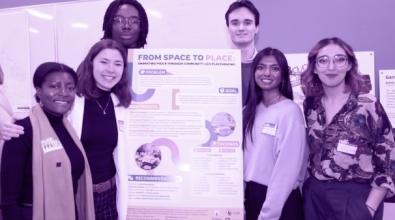 Read More
Read More
Taking transparency to the next level in cities

Mayor Michelle Wu is bringing city operations out into the open in Boston, while local leaders are spotlighting service delivery in Syracuse, N.Y. Photo by Mike Mejia, courtesy of City of Boston/Photo courtesy of City of Syracuse/iStock
Listen to This Article
Whether it’s erecting glass-walled municipal buildings or launching open-data platforms, cities have long strived to be transparent as a way to engender trust in government. Yet, as confidence in public institutions continues to be challenged, local leaders also realize that the old ways of “being open” aren’t enough—and that they have to do more.
A growing number of cities are responding by pushing the boundaries of transparency. Syracuse, N.Y., is reimagining service-delivery communications. Portland, Ore., is raising the bar for open procurement. And Boston is making the mayor’s one-on-one meetings accessible in public spaces. These efforts underscore a key lesson: innovation is essential to advancing transparency and deepening public trust.
Lifting the curtain on service delivery.
When cities provide granular insight into the work they are doing to address residents’ needs, research suggests it can increase resident engagement and trust in public institutions. Now, cities that have long made progress on this front are doubling down on connecting the dots between what residents need and what they provide them.
Take Syracuse. The city—which participated in the Bloomberg Philanthropies-supported Innovation Team (i-team) program—is already a leader when it comes to showing its work by, for example, providing a near-real-time map of snow plows clearing the roads. The idea with that effort is not only that residents can use the tool to plan their days, but also see evidence of the city at work. And now, Chief Operating Officer Conor Muldoon is working with his team to identify new ways to better showcase the efforts of civil servants.
For example, as part of a new feature planned for the city’s 311 system, Syracuse won’t just update residents on the status of their requests for service, such as which agency is working on it. It will also tell them the job title of the civil servant helping them—and provide a picture of the request being addressed.
These are simple steps, and not unprecedented ones. But they represent precisely the sort of human touch and visual proof of service that studies show have a real impact on perceptions of government. And they reflect iteration not just on how the city delivers, but how local leaders spotlight that delivery.
“It's imperative that we give city employees and frontline employees the tools to document and analyze and communicate all of the work that they're doing,” Muldoon says.
Shining new light on each step of the procurement process.
If providing concrete evidence of the work that goes into services reaching residents is one way cities can be more deeply transparent, procurement—and the spending of public dollars—is another crucial arena for this work. That’s why local leaders are taking new measures not just to disclose contracts, but to bring light to the nitty-gritty of the process to show residents that their government is working as it should be.
In 2021, Portland earned Silver What Works Cities Certification, a Bloomberg Philanthropies standard of excellence for exceptional data capabilities. The efforts it took the city to reach that level of data fluency now have it primed to standardize an array of data sets on suppliers, contracts, and purchases from across a slew of local agencies. That standardization, in turn, will be core to a new data publication the city expects to post online in the coming weeks enabling citizens to trace the trajectory of local dollars down to the level of subcontractors and, importantly, see that the city isn’t quietly picking favorites.
As part of this effort, the city is also working to provide residents with indicators capturing each time money goes out the door, rather than just the initial contract award, so they can better track progress.
“There's a lot of collective illusions about government waste,” explains Gennie Nguyen, a performance manager on the procurement team who’s helping steer this work. By using data to show residents how funds are being used—from start-to-finish—the city hopes it can instill confidence in how taxpayers’ money is being spent.
“I see transparency as this first step to the results that we're trying to drive for Portland residents,” Nguyen says.
Demystifying the mayoral workflow.
Taking deliberate steps to offer residents a look under the hood of government is sometimes called “operational transparency.” And no city has been a bigger leader on that front than Boston, especially under Mayor Michelle Wu.
The city has repeatedly invited Ryan Buell, a Harvard University scholar whose research developed the concept of operational transparency in the private and public sectors, to work with city staff. That’s encouraged city hall teams to consider how the process of service delivery—rather than only the services themselves—can be a force for greater trust in government. For example, the city is currently exploring how to better use digital platforms to send residents incremental evidence of progress on longer-term infrastructure improvements.
“You're making sure, across all departments, that folks are getting that same feeling, that same reaction, that same case closure,” says Michael Brohel, superintendent of basic city services in Boston.
This focus on operational transparency has prompted Mayor Wu to rethink the way she works, too. Rather than holding one-on-one meetings primarily in her city hall office, she can often be found doing so in public spaces—including at local libraries. The change makes Wu’s workday more open and less walled off from the public, showing residents she has nothing to hide.
And according to Mayor Wu’s chief of staff Tiffany Chu, it’s having an impact, with citizens appreciating that the mayor is so visible in the community—not just at parades and other public functions, but while making the machinery of government function.
“Now, more than ever, we have to go above and beyond to prove it to our constituents that we are doing the right thing,” Chu says.

